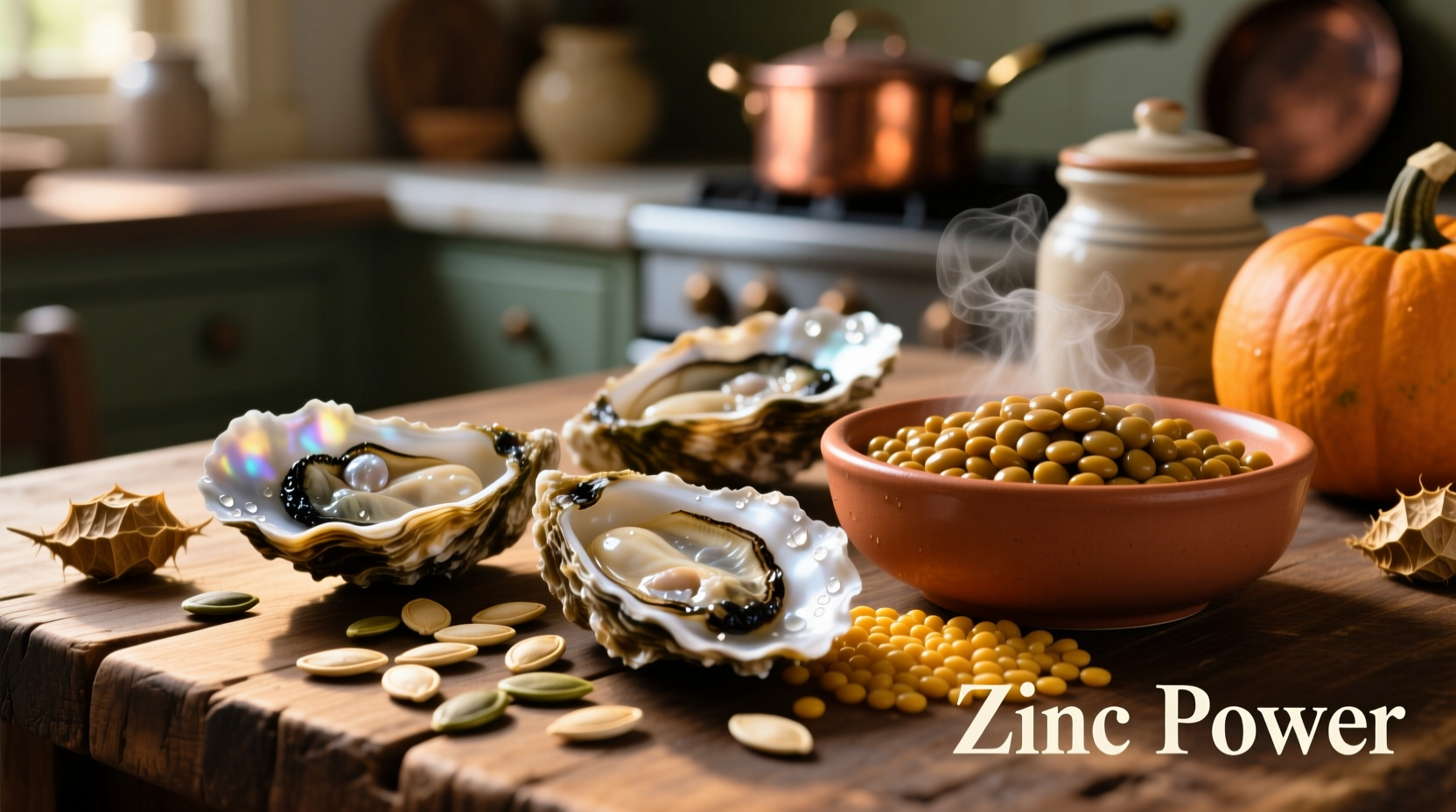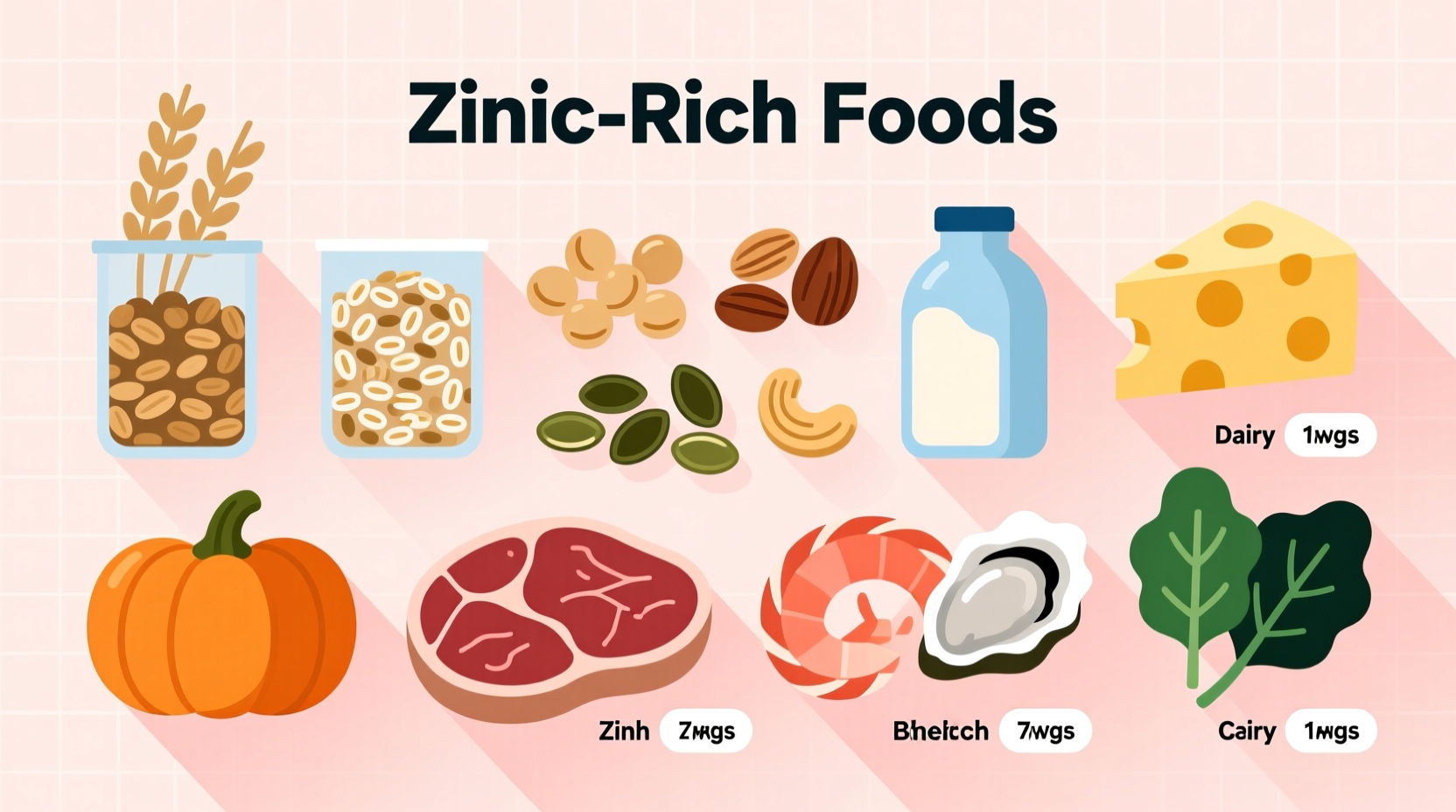The most zinc-rich foods include oysters (providing over 500% of your daily needs in just 3 ounces), beef, crab, pumpkin seeds, and lentils. Animal-based sources offer higher bioavailability (15-40% absorption), while plant sources provide valuable zinc but with lower absorption rates (5-20%) due to phytates. This guide details 25+ zinc-rich foods with exact measurements, absorption tips, and dietary considerations for different lifestyles.
When you're searching for what food contains zinc, you're likely looking for practical dietary solutions—whether you're addressing potential deficiency, optimizing your nutrition, or simply expanding your knowledge of essential minerals. Zinc plays a critical role in immune function, DNA synthesis, and wound healing, making it one of the most important trace elements your body needs regularly.
Why Zinc Matters for Your Health
Zinc isn't just another mineral on a nutrition label—it's fundamental to over 300 enzymatic reactions in your body. According to the National Institutes of Health, inadequate zinc intake can lead to impaired immune response, slower wound healing, and even altered taste perception. The recommended daily allowance (RDA) varies by age and gender:
- Adult men: 11 mg
- Adult women: 8 mg
- Pregnant women: 11 mg
- Lactating women: 12 mg
While severe deficiency is uncommon in developed countries, marginal insufficiency affects approximately 17% of the global population according to WHO data, making strategic dietary choices essential.
Top Animal-Based Zinc Powerhouses
Animal proteins provide zinc in a highly bioavailable form called 'free zinc,' which your body absorbs more efficiently than plant-based zinc. Here are the most concentrated sources:
- Oysters - A single 3-ounce serving delivers a staggering 74 mg (673% of RDA)
- Beef chuck roast - 3 ounces provides 7 mg (64% of RDA)
- Alaskan king crab - 3 ounces contains 6.5 mg (59% of RDA)
- Beef liver - 3 ounces offers 4 mg (36% of RDA)
- Lobster - 3 ounces delivers 3.4 mg (31% of RDA)
For those following a carnivore diet or paleo eating pattern, these foods naturally provide substantial zinc without supplementation concerns.
Plant-Based Zinc Sources for Vegetarians and Vegans
Finding zinc rich foods for vegetarians requires strategic planning since plant sources contain phytates that inhibit absorption. However, with proper preparation techniques, you can significantly increase bioavailability:
| Food | Serving Size | Zinc Content | % RDA | Preparation Tip |
|---|---|---|---|---|
| Pumpkin seeds | 1 oz (28g) | 2.2 mg | 20% | Soak overnight before eating |
| Lentils | 1 cup cooked | 2.5 mg | 23% | Serve with vitamin C-rich foods |
| Chickpeas | 1 cup cooked | 2.5 mg | 23% | Ferment into hummus |
| Quinoa | 1 cup cooked | 2.0 mg | 18% | Rinse thoroughly before cooking |
| Tofu | 1/2 cup | 1.9 mg | 17% | Choose calcium-free varieties |
Research from the American Journal of Clinical Nutrition shows that vegetarians may need up to 50% more zinc than non-vegetarians due to lower absorption rates from plant foods. Soaking, sprouting, and fermenting plant foods can reduce phytate content by 20-60%, dramatically improving zinc availability.
Maximizing Zinc Absorption: Practical Strategies
Knowing what food contains zinc is only half the equation—you also need to optimize absorption. Consider these evidence-based approaches:
- Pair with vitamin C - Consuming zinc-rich foods with citrus fruits, bell peppers, or tomatoes can increase absorption by up to 30%
- Avoid simultaneous calcium intake - High-calcium foods consumed at the same time can reduce zinc absorption by 50%
- Time your coffee and tea - Tannins in these beverages can inhibit zinc absorption; consume them between meals rather than with zinc-rich foods
- Use cast iron cookware - Cooking acidic foods in cast iron can add small amounts of bioavailable iron and zinc to your meals

Special Dietary Considerations
Different lifestyles require tailored approaches to zinc nutrition:
For Vegetarians and Vegans
Plant-based diets require careful planning to meet zinc needs. The Academy of Nutrition and Dietetics recommends vegetarians consume 1.5 times the standard RDA. Focus on:
- Sprouted grains and legumes
- Nutritional yeast (1 tbsp provides 0.7 mg)
- Hemp seeds (3 tbsp contains 2.2 mg)
- Fortified breakfast cereals
For Athletes and Active Individuals
Physical activity increases zinc loss through sweat. Endurance athletes may need 15-20% more zinc than sedentary individuals. Consider adding:
- Extra servings of zinc-rich proteins post-workout
- Zinc-fortified sports nutrition products
- Monitoring for signs of deficiency during intense training periods
Recognizing Zinc Deficiency
While severe zinc deficiency is rare, marginal insufficiency affects many people. Common signs of zinc deficiency in adults include:
- Frequent colds and infections
- Slow wound healing
- Loss of appetite
- White spots on fingernails
- Impaired sense of taste or smell
If you suspect deficiency, consult a healthcare provider before supplementing, as excessive zinc intake can cause copper deficiency and gastrointestinal issues.
Practical Meal Planning with Zinc-Rich Foods
Creating balanced meals that maximize zinc intake doesn't have to be complicated. Try these simple combinations:
- Breakfast: Oatmeal topped with pumpkin seeds and sliced strawberries (vitamin C boost)
- Lunch: Lentil soup with a side of orange slices
- Dinner: Grass-fed beef stir-fry with broccoli and bell peppers
- Snack: Hummus with carrot sticks
For those following specific dietary patterns like Mediterranean diet zinc sources or keto diet zinc foods, focus on incorporating appropriate high-zinc options within your framework.
Frequently Asked Questions
Can you get enough zinc from plant foods alone? Yes, but it requires careful planning. Vegetarians need approximately 50% more zinc than non-vegetarians due to lower bioavailability. Soaking, sprouting, and fermenting plant foods can significantly improve zinc absorption from sources like legumes, seeds, and whole grains.
Which seafood has the most zinc? Oysters are the undisputed champion, providing over 500% of your daily needs in just 3 ounces. Following oysters, Alaskan king crab, lobster, and mussels offer substantial zinc content with excellent bioavailability.
How does cooking affect zinc content? Zinc is relatively stable during cooking, but preparation methods matter. Boiling can leach small amounts into cooking water, while grilling or roasting preserves more. For plant foods, proper preparation (soaking, sprouting) is more impactful for absorption than cooking method alone.
What's the difference between zinc from animal vs plant sources? Animal-based zinc (heme zinc) has 15-40% absorption rates, while plant-based zinc (non-heme) has 5-20% absorption due to phytates. Animal sources provide zinc in a more bioavailable form, but plant sources can be optimized through food preparation techniques.
Can you have too much zinc from food? It's extremely difficult to overdose on zinc through food alone. The upper limit for adults is 40 mg daily from all sources. Consuming excessive amounts through supplements can cause nausea, vomiting, and copper deficiency, but dietary zinc from whole foods poses minimal risk.











 浙公网安备
33010002000092号
浙公网安备
33010002000092号 浙B2-20120091-4
浙B2-20120091-4